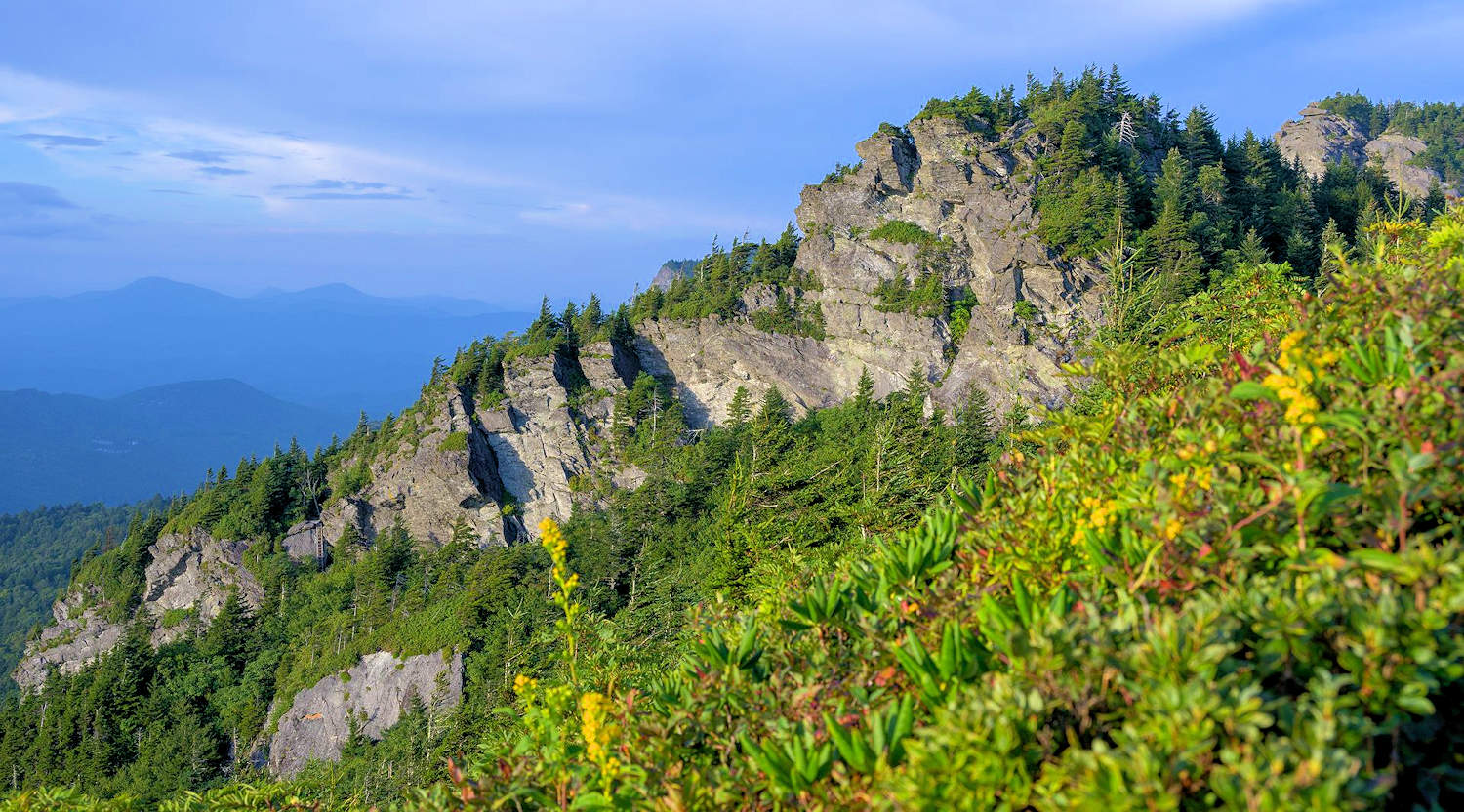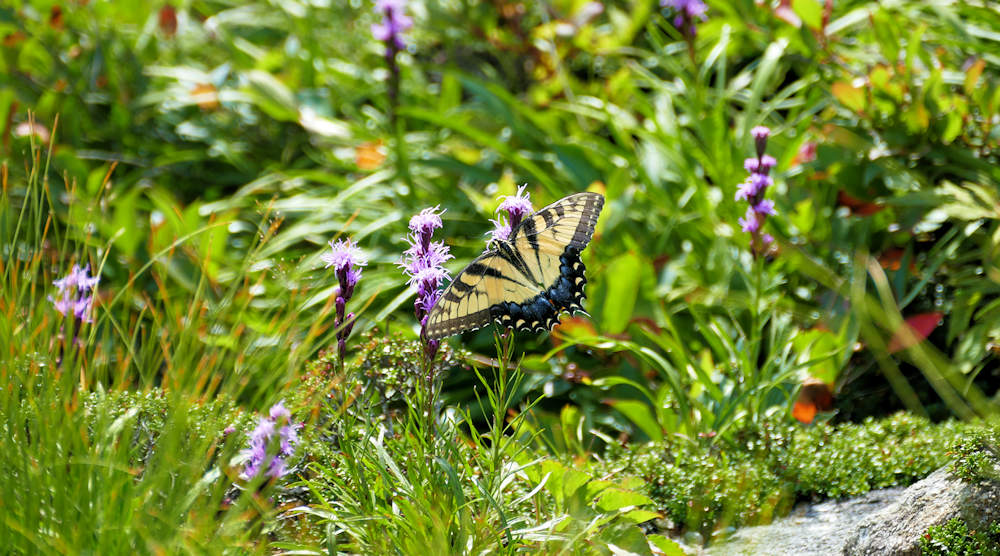
16 Natural Communities
Grandfather Mountain is home to a world of unique biodiversity, much of which is found no other place on Earth. This distinctive world of flora and fauna can be encountered throughout Grandfather Mountain’s 16 different natural communities. Each community hosts its own unique ecosystem, in which every single lifeform, whether it be a flower, plant, invertebrate, amphibian, or other creature, plays an integral role in keeping this ecosystem alive and flourishing.
To encounter the same breadth of biodiversity that exists on Grandfather Mountain, one would have to travel the length of the East Coast from Georgia to Maine to witness a similar assortment of plants and animals. In comparison, these same species can be found by simply traversing between the base of the mountain near the Wilson’s Creek area to the very top at Calloway Peak.
Grandfather Mountain’s 16 natural communities transition from one to the other as the mountain’s sharp elevation gain rises from forests similar to those found throughout the Southeast and ends amongst rugged, rocky summits and forests of Red Spruce and Fraser fir that are more commonly encountered in northern climates such as those in Canada.
Throughout this elevation gain, the 16 natural communities often overlap as Grandfather Mountain’s soil, hydrology, topography, and elevation make up the features of each natural community, many of which are host to rare or endangered species like Wellers Salamanders, Carolina Northern Flying Squirrels, Blue Ridge Golden Rods, Grays Lilies, and others.
Even on the drive from the Entrance Gate to the Top Shop, visitors pass through as many as four different natural communities, including Northern Hardwood Forests and Acidic Cove Forests. Then on the walk from the Top Shop parking lot to the Mile High Swinging Bridge, visitors walk past four federally listed endangered species.
Grandfather Mountain’s 16 Natural Communities:
- Fraser Fir Forest: Covers the highest mountain forests, in which Fraser firs naturally dominates the landscape
- Red Spruce-Fraser Fir Forest: Covers high mountain forests in which Red Spruce trees,with or without Fraser firs or hardwoods, are naturally dominant.
- Heath Bald: Persistent natural high elevation shrub lands, dominated by various evergreen shrubs.
- High Elevation Red Oak Forest: Northern Red Oak or one-time Northern Red Oak and American Chestnut forests at higher elevations generally above 3500 feet.
- Montane White Oak Forest: ominated by mixtures of oaks with White Oaks as a significant component.
- Northern Hardwood Forest (Typic Subtype): Forests of higher elevations that are neither adapted to particularly dry nor particularly wet environments. They occur on exposed or somewhat sheltered sites and are generally dominated by Swamp Birch, American Beech, Sugar Maple, or Sweet Buckeye.
- Northern Hardwood Forest (Beech Gap Subtype): Encompasses forests strongly dominated by American Beech at very high elevations.
- Boulderfield Forest: Vegetated boulderfields at high elevations (generally above 4000 feet), with dominant tree canopies.
- Rich Cove Forest: Low to mid elevation mountain and foothill forests that are neither adapted to particularly dry nor particularly wet environments with a diverse mix of trees and herbs that includes species of richer soils.
- Acidic Cove Forest: Low to mid elevation mountain and foothill forests dominated by combinations of acid-tolerant trees that are neither adapted to particularly wet or dry environments
- Canada Hemlock Forest: Mountain and foothill forests dominated by Eastern Hemlocks, with acid-tolerant undergrowth and low species richness.
- Montane Calcareous Cliff: Steep-to-vertical, sparsely vegetated rock outcrops on river bluffs, lower slopes, and other topographically sheltered locations.
- High Elevation Seep: Communities intermediate between Mountain Bogs, Wetlands, Upland Seepages and Spray Cliffs
- Spray Cliff: Small patch wetlands that are saturated for long periods by seepage of shallow or deep groundwater or by spray from waterfalls, with limited or no surface flooding or ponding of water.
- High Elevation Rocky Summit: Communities of flat-to-vertical outcrops of fractured rock on ridge tops, upper-to-mid slopes, or other topographically exposed settings, at high elevations.
- High Elevation Granitic Dome: Communities of large, smooth, exfoliation surfaces of granitic rock, occurring at higher elevations generally above 3000 feet
The mountainous regions across North Carolina and Tennessee are home to some of the highest peaks within the Appalachian Mountains. Yet even compared to neighboring Mount Mitchell and Roan Mountain, Grandfather Mountain sets itself apart due to the presence of plant and animal species that are acclimated to both the high and low elevation environments.
For this reason, Grandfather Mountain is unlike any other place in the world, and the environmental stewardship of the mountain by biologists, researchers, conservationists, and most importantly its visitors, ensures that the mountain’s unique web of life will be protected for generations to come.

Hikes to See Natural Communities
- Black Rock Trail: Starts out in Red Spruce-Fraser Fir Forest and the majority of the trail passes through Northern Hardwood Forest.
- Bridge Trail: Red Spruce-Fraser Fir Forest to High Elevation Rocky Summit in the Swinging Bridge area
- Grandfather Trail: Mostly Red Spruce-Fraser Fir Forest, and as you approach Calloway Peak you enter Fraser Fir Forest.
- Grandfather Extension Trail: Weaves between Red Spruce-Fraser Fir Forest, and Northern Hardwood Forest.
- Profile Trail: Contains (in order from the bottom of the trail) Rich Cove Forest, Acidic Cove Forest, Canada Hemlock Forest, Boulderfield Forest, High Elevation Seep, Spruce-Fir Forest.
- Underwood Trail: Hike through a Boulderfield Forest.
- Woods Walk: Great and accessible example of Northern Hardwood Forest.
- Cragway Trail: Passes through Northern Hardwood Forest and also Heath Bald.
- Daniel Boone Scout Trail: Weaves through (from the parkway to Calloway) Acidic Cove Forest, Northern Hardwood Forest, Red Spruce-Fraser Fir Forest, a Heath Bald, and finally Fraser Fir Forest up at Calloway Peak.
Find the Faces and Profiles of Grandfather.
Read more: Grandfather’s Unique Ecology | International Biosphere Preserve | Preserving Grandfather
